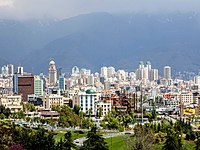
Photo from wikipedia
Abstract International shipping accounts for around 2 % of global CO2 emissions. The International Maritime Organization (IMO) has set the ambition to halve shipping GHG emissions by 2050 to help mitigate… Click to show full abstract
Abstract International shipping accounts for around 2 % of global CO2 emissions. The International Maritime Organization (IMO) has set the ambition to halve shipping GHG emissions by 2050 to help mitigate climate change. As shipping connects countries and sectors, its future development is highly dependent on regional and sectoral trends. So far, the literature on the decarbonization of shipping has focused on sectoral analyses while integrated assessment models (IAMs) have paid little attention to this matter. In this study, the IMAGE model is used to assess different futures of energy, agricultural and industry impacting the effort required to meet IMO's target for 2050. To that end, long-term seaborne trade projections are created from outputs of the IMAGE model. The results show that varying pathways of socio-economic development strongly affect the size of the sector. The mass shipped globally ranges from 17 to 35 Gt/yr in 2050. This corresponds to an energy demand between 9 and 25 EJ in the same year, which would require significant amounts of low-carbon fuels. Interestingly, in a climate policy scenario, the avoided trade of fossil energy, although partially compensated by an increase of biofuel trade, lowers the international shipping mitigation effort.
Journal Title: Energy
Year Published: 2021
Link to full text (if available)
Share on Social Media: Sign Up to like & get
recommendations!